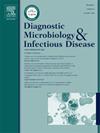Metagenomic next-generation sequencing of bronchoalveolar lavage fluid samples offers diagnostic utility in bacteriologically negative pulmonary tuberculosis
IF 2.1
4区 医学
Q3 INFECTIOUS DISEASES
Diagnostic microbiology and infectious disease
Pub Date : 2025-02-08
DOI:10.1016/j.diagmicrobio.2025.116725
引用次数: 0
Abstract
Rapid diagnosing Mycobacterium tuberculosis (M. tb) in patients with pulmonary tuberculosis (PTB) cases is critical, particularly in cases without bacteriologically confirmed disease, as it enables timely treatment initiation and can thus interrupt further disease transmission. In this study, the utility of metagenomic next-generation sequencing (mNGS) as a diagnostic tool was evaluated using samples of bronchoalveolar lavage fluid (BALF) samples from 300 bacteriologically negative PTB (BN-PTB) patients hospitalized from January 2020 through December 2023. The diagnostic performance of mNGS was compared to that of acid-fast staining (AFS), conventional Roche culture, and the Xpert method among these BN-PTB patients, using clinical diagnosis as the gold standard. The final analyses enrolled 112 PTB patients and 188 non-PTB cases. These analyses revealed that mNGS-based M. tb detection yields a sensitivity of 94.64 % (106/112), a specificity of 98.94 % (186/188), a positive predictive value (PPV) of 98.15 % (106/108), and a negative predictive value (NPV) of 96.88 % (186/192). This mNGS approach outperformed the AFS, Roche culture, and Xpert methods in terms of sensitivity, specificity, PPV, and NPV (p < 0.05). The superior diagnostic performance of this approach was further supported by its area under the curve and corresponding confidence intervals. Together, these data demonstrate that mNGS can improve the detection of M. tb in BALF samples from BN-PTB patients with high levels of speed, sensitivity, and specificity. This mNGS approach may thus be a valuable diagnostic tool for the rapid detection of M. tb in BN-PTB, providing a foundation for the precision diagnosis and treatment of PTB in the future.
求助全文
约1分钟内获得全文
求助全文
来源期刊
CiteScore
5.30
自引率
3.40%
发文量
149
审稿时长
56 days
期刊介绍:
Diagnostic Microbiology and Infectious Disease keeps you informed of the latest developments in clinical microbiology and the diagnosis and treatment of infectious diseases. Packed with rigorously peer-reviewed articles and studies in bacteriology, immunology, immunoserology, infectious diseases, mycology, parasitology, and virology, the journal examines new procedures, unusual cases, controversial issues, and important new literature. Diagnostic Microbiology and Infectious Disease distinguished independent editorial board, consisting of experts from many medical specialties, ensures you extensive and authoritative coverage.

 求助内容:
求助内容: 应助结果提醒方式:
应助结果提醒方式:


